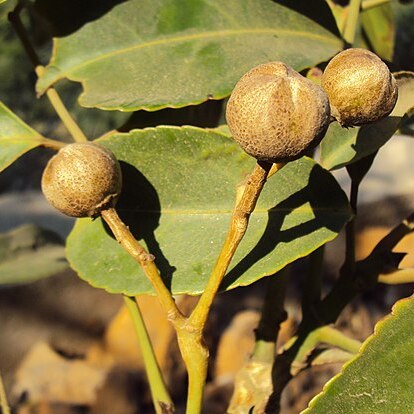Evergreen trees or shrubs with terete, pithy twigs; pith terete. Indument, if present, consisting of simple hairs. Stipules interpetiolar, 2 to each node, partly inserted in the axil of the petioles, imbricate, entire, rarely 2-tipped, early caducous (except in T. stipulacea), leaving a distinct annular scar. Leaves decussate, simple or odd-pinnate; petiole sulcate. Articulations (base of petiole, nodes of rachis) shrinking in the dry state. Two small glands (sometimes called stipels) on the rachis near the insertion of the petiolules and also 2 near the base of the leaflet. Leaflets 3-11 in compound leaves, herbaceous to subcoriaceous, mostly 2-3 times as long as wide, penninerved, midrib prominent, apex acute to acuminate, base obtuse to rounded, sometimes cuneately decurrent, margin glandularly serrate, dentate or crenate. Panicles axillary, terminal or subterminal, mostly glabrous. Bracts small. Pedicels with or without 1 or 2 minute bracteoles, not articulated with the flower, apically widened into the short obconical receptacle. Flowers regular, bisexual, 5-merous. Sepals persistent, free, imbricate, the outer ones broader than the inner ones, ovate, broadly attached at the base, rounded at the apex, fleshy, more or less ciliate at the margin. Petals free, imbricate, spathulate or oblong-elliptic, or obovate, equal-sized, narrowly attached, membranous, more or less ciliate at the margin, longer than the sepals, caducous. Stamens 5, episepalous, equal; filaments linear, gradually widened to the base, (in Mal. spp.) glabrous, inserted close to the disk, caducous; anthers rounded or ovate, with spreading cell-bases, dorsifixed, dehiscing lengthwise, introrse, sometimes distinctly apiculate. Disk annular, glabrous and crenate, fleshy. Ovary superior, (2-)3(-4)-celled, the three cells and styles closely appressed but not connate, the combined stigmas 3-lobed. Ovules 1-∞ in each cell, anatropous, attached on the dissepiment very close to the axis, in 2 vertical rows. Fruit up to 2.5 cm diam., with a more or less fleshy pericarp (in dry state rather hard), indehiscent, globular, slightly 3-lobed, sometimes crowned by the horn-like conical style remains. Seeds 1-∞ in each cell, of various shape, mostly roundish or reniform, or compressed, yellow-brown to dark-brown when dry; hilum large; endosperm present; cotyledons flat, roundish.
More
Trees or shrubs. Leaves opposite, petiolate; blades simple or pinnately com-pound; leaflets serrate; venation pinnate; stipules and stipels usually present. In-florescences terminal or in the axils of the upper leaves, paniculate or thyrsiform. Flowers complete, bisexual and actinomorphic; sepals 5, free, unequal, imbricate; petals 5, free, unequal, imbricate in bud, inserted on or below a hypogynous crenate or lobed disc; stamens 5, arising between the lobes of the disc, alternate with the petals, the filaments complanate, the anthers 2-celled, dehiscing longi-tudinally; ovary superior, entire or lobed, 3-locular, 3-carpellate, sessile, the placentation axile, the ovules few, anatropous, the styles 3, free or united, the stigmas capitate. Fruit a berry; seeds with straight embryo and fleshy endosperm. Turpinia is a genus with probably fewer than 10 species. A single variable species occurs in Panama, and 2 or 3 other taxa occur also in Central America, though all may be only subspecifically distinct.
Trees or shrubs, evergreen or deciduous. Leaves opposite, exstipulate, odd-pinnately compound or simple; petiole constricted at tip; leaflet blades leathery, sometimes with stipels. Inflorescence a panicle, terminal or axillary. Flowers small, white, actinomorphic, bisexual, rarely unisexual. Sepals 5, imbricate, persistent. Petals 5, rounded, sessile, imbricate. Stamens 5, arranged at margin of disk; filaments flat. Floral disk conspicuous, margin undulate. Ovary sessile, 3-locular; styles 3, separate or united; stigmas capitate; ovules anatropous, numerous, arranged in 2 rows. Berry subglobose, indehiscent. Seed coat hard membranous or osseous.

